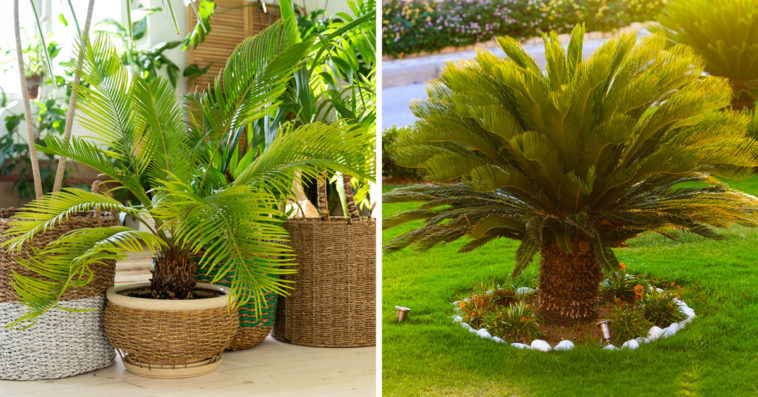The Cycas is an indoor and outdoor plant with pointed, green and shiny leaves. This beautiful plant can reach a maximum height of 3 meters and has more than 80 species, of which Cycas Revoluta and Cycas Angulata are the best known.
Cycas Revoluta © stock.adobe
For example, the Cycas Angulata, in particular, can reach a height of 12 meters, which is unusual for this species. The Cycas is a hardy but very poisonous plant, so it is always advisable to protect your hands with gloves when handling it. Also, for this reason, it is not appropriate for pets to approach them.
Origins of Cycas
It belongs to the Cycadaceae family, woody species that resemble the Palmaceae. The Cycas comes from tropical Asia and Oceania and is called a “prehistoric plant” because fossils of this species have been found dating back 250 million years.
Cycas is a slow growing plant that is widespread in many parts of the world. The trunk of the Cycas is made of bark, is sturdy and has a diameter of about 20 cm.
© stock.adobe
The foliage may exceed in diameter and its leaves, which are acuminate, are broad. The evergreen leaves are attached to the stem and have a medium-sized thorn at the end. The Cycas is a dioecious species: in nature there are female and male specimens that differ in their leaves. This plant blooms in the spring when it becomes an adult.
© stock.adobe
Male species have clusters of white or pale yellow flowers; female plants, on the other hand, have flowers that look like small leaves gathered into a rounded structure. The Cycas, as we have mentioned, is a very old plant, and its evolution from prehistoric times to the present day has been very minimal: the current evolution is practically the same as that of the origins of the world.
Cycas: culture
The Cycas is a plant that requires little maintenance. When grown in soil, the soil in which it grows should be moist, but waterlogging should be avoided. If grown in a container, water only when the substrate is completely dry. In winter, the Cycas should never be watered, especially if the temperatures drop below 15 °.
Cycas in pot © stock.adobe
When underground, Cycads like organic fertilizers, especially in the spring. When in pots, they must be fertilized every 2 months (from March to October) using a specific liquid product for green plants, diluted according to the instructions on the packaging. When there are dry or damaged leaves, they should be removed immediately with scissors, or pulled down. If the plant is kept in an apartment, the leaves should be sprayed with deionized water to increase the general humidity of the environment.
© stock.adobe
How to take care of a Cycas
Cycads don’t need a lot of care. They are very hardy and can be kept indoors or outdoors. These plants love direct sunlight and high temperatures. If they are placed indoors, they should be placed where they can fully develop their foliage, which can reach a meter and a half in length. When potted, the Cycas should be neither too small nor too large.
The Cycas plant can be attacked by pests such as the white mealybug, which can attack the leaves and prevent growth. To eliminate the problem, one must use natural methods that are not harmful to nature or humans. Nettle macerate, for example, or pure Marseille soap, soft potash soap, Neem oil or fern macerate.
Diseases in Cycads
Fertilization of Cycas takes place from spring until all summer. The fertilizer is given by irrigation because it is diluted in water. The fertilizer used must be rich in microelements. When the plant turns yellow, it means the mealybug is inactive and broad-spectrum antibiotics should be used. Besides mealybugs, red spiders also attack Cycads. The red spider can attack the plant if there is little sun and little humidity. With an acaricide sprayed on the plant, the problem can be easily solved.
© stock.adobe
To control the mealybug, you can either pull the plant out by hand or use mineral oil reinforced with a systemic insecticide. If the leaves and trunk of the Cycas show spots, it means the plant has been overwatered and is rotting. The leaves can therefore warp, and this also happens if the Cycas is not exposed to a lot of sunlight.
To see also:
A bougainvillea to embellish the entrance: 8 splendid inspirations for the home
SHARE ON:
Follow Ehomedecor.net on


